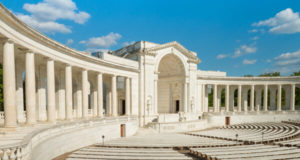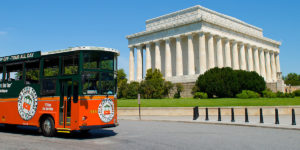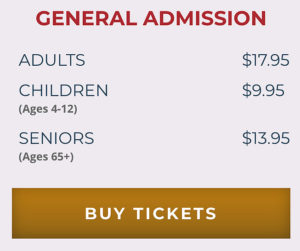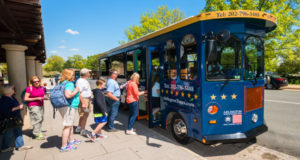Learn about the Tomb of the Unknown Soldier
-
Overlooking the nation’s capital from its serene 624-acre hilltop perch, Arlington National Cemetery is located on the resplendent west bank of the Potomac River. The hallowed ground serves as the final resting place for numerous presidents, Supreme Court justices, astronauts and other public servants, including more than 400,000 military personnel, veterans and their immediate families. This national landmark is the country’s largest and most important military cemetery. Still an active burial ground, it conducts over 25 funerals each weekday. The cemetery, Arlington Memorial Bridge, the Hemicycle and Arlington House make up the Arlington National Cemetery Historic District that was added to the National Historic Register in 2014.
History of an Honored Cemetery
Arlington National Cemetery occupies land once owned by George Washington Parke Custis, the adopted grandson of Martha and George Washington. He built the Arlington House as a memorial to the nation’s first president. In 1857, the property was bequeathed to his daughter Mary Anna Randolph Custis who had married Robert E. Lee 26 years earlier. With the secession of Virginia from the Union, the family evacuated the property. Federal troops incorporated the land into their defensive fortifications around Washington. Part of the property was used as a Freedman’s Village where former slaves received assistance after their liberation.
As the number of casualties climbed during the Civil War, the federal government needed additional cemetery space to inter the dead. To meet this demand, 200 acres of the plantation was set aside as a cemetery. In May 1864, Private William Christman was the first military casualty to be buried in the newly created graveyard. The following month, the War Department designated the space as a national cemetery. After the war, George Washington Custis Lee sued the federal government for return of the land, which he argued had been seized illegally. In 1882, the Supreme Court ruled in his favor and the federal government paid Lee $150,000 for the property, which is equivalent to $3.2 million in 2016. Further along the landmark’s timeline, President Herbert Hoover oversaw the first Memorial Day ceremony on May 30, 1929.
The Tomb of the Unknown Soldier
Despite the many distinguished and revered war heroes and two former U.S. Presidents buried there, there is nowhere within the hallowed grounds of Arlington National Cemetery that is more frequented by visitors than The Tomb of the Unknown Soldier. Located on a hill on high ground at almost the perfect geographic center of the cemetery, the tomb exemplifies valor and honor by remembering those who died committing brave and selfless acts with no one to bear witness to them. What is it about this place that so intrigues the many who visit it every year? What’s the story behind it and what does it take to become one of the select few to stand watch over it?
The First, But Not The Last
On August 3, 1956, President Dwight D. Eisenhower signed a bill into law whose purpose was to select and pay tribute to the fallen unknown soldiers of the Korean War and World War II (WWII) by interring them with honors in a specially designated area in Arlington National Cemetery. The idea of the tomb itself was initially inspired by the multitudes of unknown dead that had amassed by the end of World War I (WWI). It was in Great Britain, however, where the idea of honoring these forgotten warriors first took root in 1920. The following year, a burial ceremony was planned in the United States for an American unknown who died in Europe during the First World War. On Memorial Day, 1921, four unknowns were exhumed from an American cemetery in France. The four were placed in identical caskets and placed before a highly decorated WWI veteran tasked with selecting one of the caskets for burial in Arlington National Cemetery. That person was U.S. Army Sergeant Edward F. Younger.
After the ceremonial selection was made, the body was to lie in state in the Capitol rotunda until midnight on November 10, 1921. On the following day, Armistice Day, the casket was placed in a caisson and transported to Arlington National Cemetery. During the procession, the casket was escorted by members of the military, President Warren G. Harding, Vice President Coolidge, Chief Justice Taft, and the remaining justices of the Supreme Court. Members of the Cabinet, Senate, and House along with several hand-picked Generals were also on hand to witness the presenting of the Medal of Honor and the Distinguished Service Cross to the unknown dead. Also honored were unknowns each from Great Britain, France, Italy, Belgium, and Romania which marked the only time these medals were issued to foreign combatants. Years later after the end of the Second World War, the selection process for the next unknown soldier from that war had to be postponed with the outbreak of war on the Korean Peninsula.
WWII & Korea
At the conclusion of the Korean War, four new candidates from that war were selected for burial at the Tomb of the Unknown Soldier from the National Cemetery of the Pacific in Honolulu. These four flag-draped coffins were placed in the stead of Master Sergeant Ned Lyle for the important task of selecting one for burial at Arlington. Eleven days later, the selection for the unknown from WWII was made aboard the U.S.S. Canberra by Navy Hospital Corpsman 1st Class William R. Charette. Unlike in previous selection processes, two were chosen in this case from both the European and Pacific theaters.
Rest in Power
When the procession entered the cemetery grounds, a squadron of 20 fighter planes flew overhead with one plane missing from each formation to symbolize a fallen or missing brother-in-arms. The Marine Band played the National Anthem and a bugler sounded attention three times. After a long moment of silence, President Eisenhower placed a Medal of Honor on each casket. Many years later, in 1984, the final unknown soldier from the Vietnam War was laid to rest; however, because of advances in genetic science and DNA technology, the body was exhumed in 1998 and tested. The body was identified as that of Air Force 1st Lieutenant Michael Joseph Blassie, who was shot down near An Loc, Vietnam in 1972. It was decided that the crypt that contained the remains of the Vietnam Unknown will remain vacant. The crypt cover has been replaced with one that has the inscription, “Honoring and Keeping Faith with America’s Missing Servicemen, 1958-1975.”
Decoding the Tomb
The sarcophagus built above the tomb of the soldier who served in WWI sits in front of the three marble slabs that identify the crypts of the soldiers from WWII, Korea and Vietnam. It was constructed in 1931 out of seven large marble panels collectively weighing 79 tons. On one side, is a relief of three Greek figures each representing Peace, Valor, and Victory. On the other side, there are sculpted six inverted wreaths each representing a major campaign from WWI.
Tomb Sentinels
The U.S. Army regiment entrusted with tending to and guarding not just the Tomb of the Unknown Soldier but the coordination and execution of any and all burials that take place in Arlington National Cemetery falls to the 3rd Infantry, affectionately known as the ‘Old Guard.’ For those select few that answer the sacred call to become a Tomb Sentinel, it is a responsibility that is taken with the utmost grace. It is a role fraught with pomp and circumstance of the highest order. For those in training to become full-fledged Sentinels, the rigors are many. From 5-5:30 am, there is a daily inspection of living quarters after which the prospects themselves are evaluated. Uniforms are inspected with a fine tooth comb to ensure that the garment is immaculate down to the prescribed distances between medals and other parts of the uniform jacket. The regiment’s motto, it can be said, is taken from the Sentinel’s Creed: “My standard will remain perfection.”
Changing of the Guard
If there is one reason, besides paying their respects and the historical significance of the place, that visitors from all over the world visit Arlington National Cemetery is to witness the iconic changing of the guard. Since April 6, 1948, the Tomb of the Unknown Soldier has been guarded 24 hours a day, 365 days a year with zero exception. Every hour during winter and every half hour during the summer and daylight hours, one guard relieves another from their post in a ceremony with the precision of a Swiss watch. While on duty, the Tomb Sentinel marches 21 steps across a black mat passing the grave markers of each of the unknowns. He then turns 90-degrees and faces east for exactly 21 seconds.
Afterward, he then turns north for another 21 seconds which is followed by a crisp shoulder arms movement where the guard places his rifle on the shoulder nearest to the spectators to symbolize that he stands between the tomb and any outside threat. The guard then paces 21 steps to the north, turns, and repeats the entire process until he is relieved. When that moment arrives, the new guard makes his way to the plaza alongside a commanding officer who makes a formal announcement to the attendees that the changing of the guard ceremony is to commence. In another elaborate military ballet, the commanding officer inspects the new guard’s weapon and uniform with extreme scrutiny. If all is in order, the relieved guard calmly makes his way back to quarters as his replacement makes his way to the center of the plaza to begin his watch.
Epilogue
Arlington National Cemetery is not just a relic but a fully operational cemetery that performs an average of four funerals daily. These are also performed by the 3rd Infantry’s Caisson Platoon with the stoicism and respect that the Tomb Sentinels display in the carrying out of their duties. No matter your political beliefs or your feelings about how countries like the United States make the critical decision to sacrifice the lives of those in military service when they are sent to war in the name of an ideal or national security, a visit to the Tomb of the Unknown Soldier, and Arlington National Cemetery as a whole, can be a life-changing event.
Other Points of Interest
Arlington National Cemetery contains several well-known burial sites and memorials, including the resting places of President John F. Kennedy and his wife Jacqueline as well as his brothers Robert and Edward. Other notable sites include Supreme Court Justice Thurgood Marshall, boxing legend Joe Louis and Audie Murphy, the most highly decorated soldier from World War II. Charles L’Enfant, who designed the city of Washington, D.C., several Tuskegee airmen and the seven Space Shuttle Challenger astronauts are also interred here.
The official tour includes a stop at Arlington House, a Greek Revival-style mansion set on a hill overlooking the Potomac River. The permanent memorial to Robert E. Lee is appointed with period furnishings from the early 19th century. Completed in 1921 from Imperial Danby marble, the Memorial Amphitheater hosts state funerals and other special events during the year. The Temple of Fame, the Civil War Unknowns Monument and the Spanish-American War Nurses Memorial and several other large monuments and memorials are dispersed throughout the park. The Women in Military Service for America Memorial is adjacent to the park’s ceremonial entrance.
Events and Holidays
The Tomb of the Unknown Soldier is guarded 24 hours a day by members of a special detail from the 3rd U.S. Infantry Regiment (The Old Guard). The sentinel does not wear any rank insignia, which ensures that the guard is junior in rank to whoever is buried in the tomb. A Changing of the Guard Ceremony takes place every half-hour from April 1 to September 30 when the park is open. The guard is changed every hour from October 1 to March 31. The symbolic guard change is conducted in accordance with Army regulations.
The two major holidays formally observed at Arlington National Cemetery are Memorial Day and Veterans Day. On these two occasions, the president of the United States or another high-ranking dignitary will lay a memorial wreath at the Tomb of the Unknown Soldier.
Just before Memorial Day, members of the Old Guard adorn the cemetery with over a quarter of a million small American flags. One flag is placed at each headstone as well as the bottom of each niche row. Known as “Flags In,” the decades-old ceremony is accomplished in four hours.
Each branch of the military service holds several memorial services and other events in the amphitheater throughout the year that are open to the public.
Best Times to Visit
The best times to visit Arlington are during the March to May and September to November foliage seasons. The blooms of spring and the changing fall colors provide a dramatic backdrop to the marble and granite markers, monuments and memorials. Many people prefer to visit during the spring and fall because temperatures during these seasons are mild and there tends to be fewer crowds. Summer months are sultry and warm, and winter months are cold and snowy.
Planning Your Trip
When planning your visit, remember to bring comfortable walking shoes and sunscreen. For hydration, keep in mind bottled water is the only refreshment allowed inside the cemetery. Expect to spend at least two to three hours exploring the graves and notable points of interest. Restrooms, a bookstore and drinking fountains are available at the Visitor’s Center.
Although Arlington National Cemetery is a beautiful setting for leisurely outdoor walks, it is still an active cemetery with funerals taking place on a regular basis. As a result, visitors are asked to remain respectful at all times in light of the somber nature of the memorial park. Silence is requested in some portions of the cemetery and visitors must also be silent and standing during the Changing of the Guard Ceremony.
Reaching the Cemetery
Via public transportation, the best way to access the cemetery is to exit the Arlington Cemetery stop on the Metrorail Blue Line. You can also reach this hallowed ground from Washington, D.C. by crossing the Arlington Memorial Bridge. The entrance to the burial ground is off George Washington Parkway, but driving is not permitted inside the park.
Touring the Grounds
Once you have arrived at the Visitor Center, you can sign up for an Arlington National Cemetery Tour that gives you the opportunity to honor and remember our nation’s fallen heroes. Running in a 45 minute continuous loop, the tour makes six stops during the week and 9 stops on weekends. Stops include the gravesite of President John F. Kennedy with its eternal flame, the Arlington House as well as the Memorial Amphitheater and the Tomb of the Unknown Soldier. Check out this interactive Arlington map to find all of the most popular sites within the cemetery. You can hop off the trolley, spend additional time walking around Arlington House, attend the changing of the guard ceremony or view a particular memorial. When you are ready, you can hop aboard the next trolley and resume the tour. Along the way you’ll travel through history while paying respect to America’s fallen heroes. The tour conductor provides insight into the cemetery’s history, famous graves and significant memorials and monuments. The respectful and educational guided tour will enable you to see more of the cemetery than you would on foot.


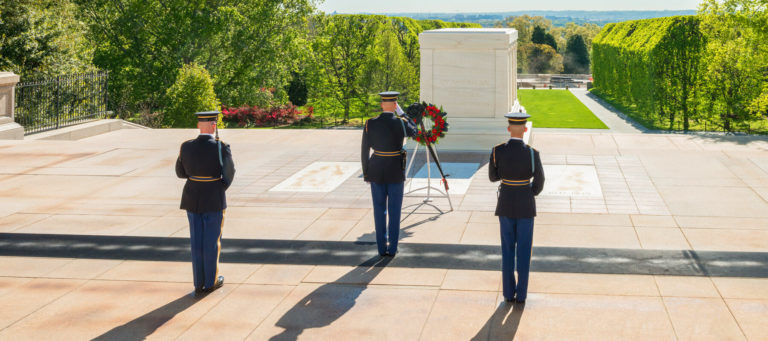
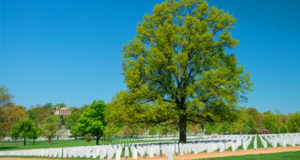
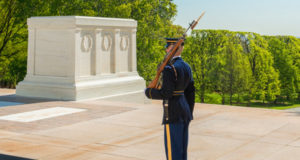
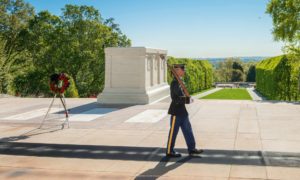
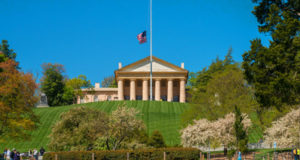 Arlington National Cemetery contains several well-known burial sites and memorials, including the resting places of President John F. Kennedy and his wife Jacqueline as well as his brothers Robert and Edward. Other notable sites include Supreme Court Justice Thurgood Marshall, boxing legend Joe Louis and Audie Murphy, the most highly decorated soldier from World War II. Charles L’Enfant, who designed the city of Washington, D.C., several Tuskegee airmen and the seven Space Shuttle Challenger astronauts are also interred here.
Arlington National Cemetery contains several well-known burial sites and memorials, including the resting places of President John F. Kennedy and his wife Jacqueline as well as his brothers Robert and Edward. Other notable sites include Supreme Court Justice Thurgood Marshall, boxing legend Joe Louis and Audie Murphy, the most highly decorated soldier from World War II. Charles L’Enfant, who designed the city of Washington, D.C., several Tuskegee airmen and the seven Space Shuttle Challenger astronauts are also interred here.